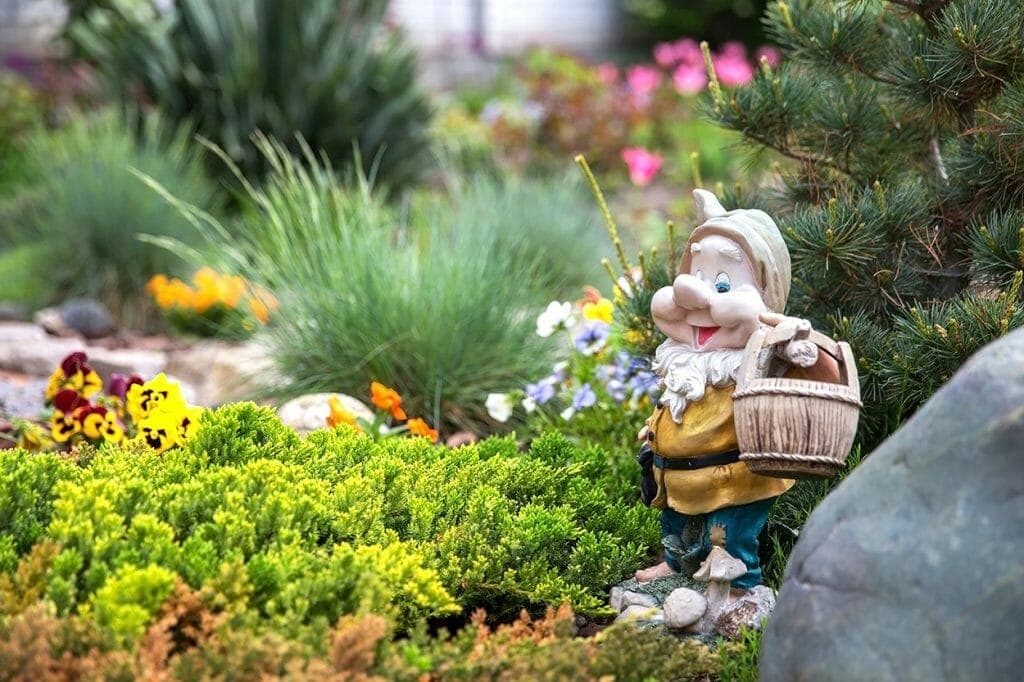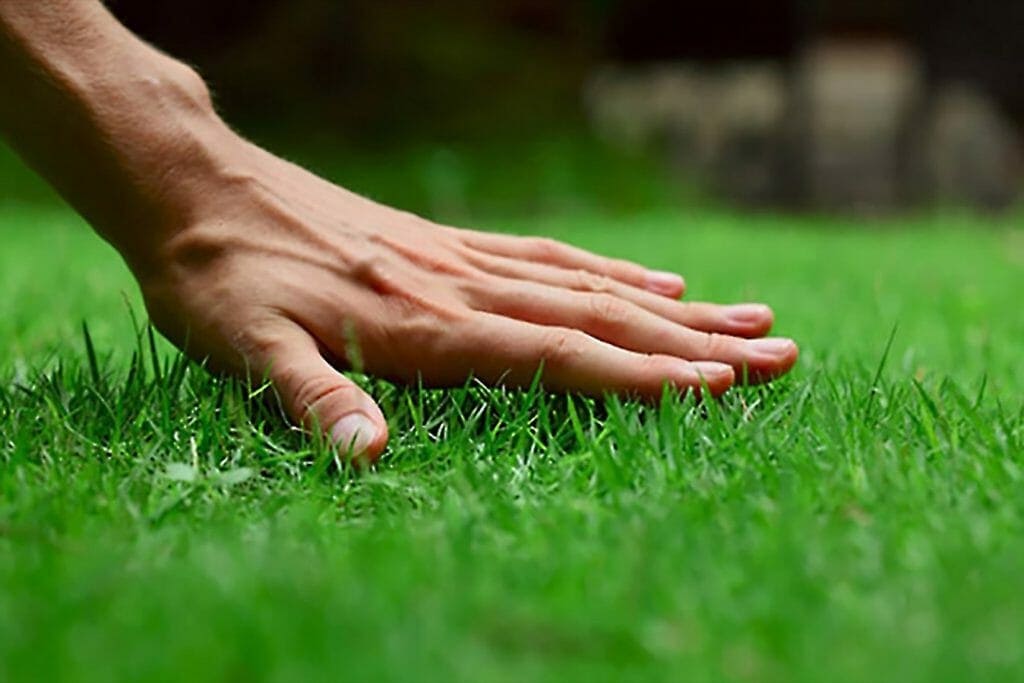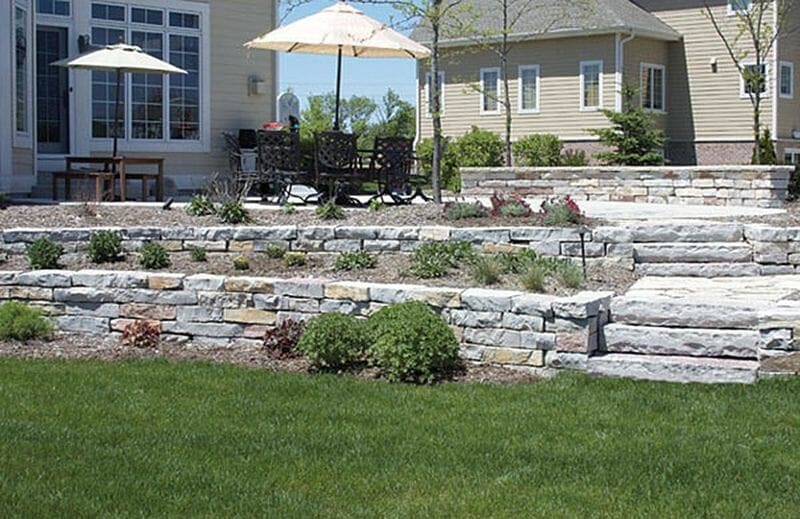Written by Lauren Dunec Hoang and published on https://www.houzz.com/.
There is no mistaking a professionally designed and installed landscape project. This design is as breathtaking at night as it is during the day thanks to the professional lighting design and installation.
The landscape around your home can make a great first impression on guests and passersby. Or it can be an eyesore that leaves everyone wondering what you were thinking when you dreamed up this design if, by chance, you even had a plan in mind. We have all seen beautiful houses that have been hidden behind hideous landscapes. It is merely a gathering of trees and plants that appear to have just meandered into the yard and taken root in random places.
Sadly many new homeowners think that landscaping is a simple task that they can easily manage on their own. It offers the opportunity for some sweat equity and saves the cost of professional landscape design and installation. But soon after they begin the process of actually installing the landscape, their opinion changes, and they discover the truth about this process. Landscape design and installation require a great deal of knowledge, skill, and effort if you want the result to look fantastic and survive the first hot summer in the Valley of the Sun.
To save homeowners from making some common and costly mistakes, we have compiled a list of the most common landscape mistakes and a UNIQUE way to avoid making them in your own yard.
Experts Share 13 Common Gardening Mistakes and How to Avoid Them
See how to avoid overwatering, spacing out plants incorrectly and other landscaping pitfalls
From overwatering to planting too tightly, some of the most common gardening mishaps are born from the best intentions. Some of these mistakes can lead to plant stress and even eventual decline.
We asked landscape experts on Houzz to shine a light on the most common gardening and maintenance mistakes they see, along with their tips for fixing or avoiding them altogether to make sure your garden thrives. Take a look at the following list. Have you ever experienced (or maybe have been guilty of) any of these planting and maintenance mishaps? The designs showcased below successfully avoid these common gardening mishaps.
If you plant a shade-loving fern in the hot sun, there’s just no way it will thrive. The same goes for putting a sun-loving plant in dark shade or planting a dry-climate shrub in an area with heavy rainfall. While this may seem obvious, planting the wrong plant in the wrong place is one of the most common gardening mistakes.
“If a plant is in the wrong sun or shade exposure, you will know right away,” says Bay Area-based landscape designer Beth Mullins of Growsgreen Design. The plant will show signs of distress, such as yellowing or burnt leaves or weak growth. Choosing a plant that will naturally thrive in your climate is just as important but can be challenging for beginning gardeners to get right.
A good place to start is to look up your climate zone. Assess the sun and shade pattern of the area you would like to plant as well as the soil type and moisture level. Cross-check with plant tags at your local nursery. A well-chosen plant, whether native or exotic, suited to your climate and site will need little care to thrive. A landscape designer can help choose plants that will grow well in your climate and garden.
Solution: Choose plants suited to your climate (check plant tag and hardiness zone); plant them in the right sun exposure and soil type. Forgetting About Soil Health
While we only see what goes on aboveground, it’s what’s below the soil surface that feeds your plants. “The English have a saying: ‘Put a 5 bob plant into a 10 bob hole,’” says Connecticut-based designer Janie McCabe of MJ McCabe Garden Design. “In other words, spend some time and effort into creating a rich, well-drained soil before putting any plants in the ground.”
She recommends conducting a basic soil test before planting to check soil pH and for the presence (or lack thereof) of essential plant nutrients and minerals. Then, she says, amend soil with high-quality compost and organic fertilizers to address any nutrient deficiencies.
Find a landscape designer on Houzz build healthy soil long term, avoid maintenance practices that strip the soil top layer and kill the beneficial organisms that help plants grow. Don’t use leaf blowers on garden beds; doing so blows off the top soil and leads to soil compaction. Instead, leave a natural leaf litter below shrubs and trees or use high-quality mulch. Avoid chemical-based fertilizers and pesticides that, if used incorrectly, can kill soil organisms.
Solution: Enrich soil with compost before planting, and adopt practices that build healthy soil long term.June Scott Design3. Overwatering
Most garden plants don’t like sitting in water-logged soil, and overwatering, particularly if soil does not drain freely, can lead to root rot and plant death.
Landscape architect Mariane Wheatley-Miller of A. J. Miller Landscape Architecture in Syracuse, New York, cites overwatering as one of most common maintenance mishaps she sees in her clients’ gardens, with too-frequent watering leading to lazy root growth. “You want plants to establish deep roots, not surface-level ones,” Wheatley-Miller says. “Overwatering makes the plants too dependent on water, rather than reaching deep for it.” One exception: plants do require frequent, consistent watering just after planting.
Donald Pell, principal designer of Donald Pell Gardens in Phoenixville, Pennsylvania, agrees that overwatering is a common — if well intentioned — maintenance problem. “We have seen many irrigation techs crank up systems and rot large sections of gardens out,” Pell says. Instead, he recommends that clients not overly rely on irrigation systems, which can “give people a false sense of security,” but rather to check on plants regularly and give water when plants show signs of needing it.
Solution: Water according to plant needs, not indiscriminately. Allow soil to dry out between waterings.A J Miller Landscape Architecture PLLC4. Underwatering
“Equally, little to no watering can be a common problem,” Wheatley-Miller says. Signs of underwatering include wilting leaves, drooping branches and dry soil. Seedlings and young plants that have yet to establish root systems are the most vulnerable to drying out; water them often.
Wheatley-Miller says she often sees mistakes around watering large shrubs and trees. “I’ll see clients water for a few minutes, not realizing that trees require a good soaking when it is hot or windy,” she says. Instead, set a hose on very low dribble and move it around the drip line of a tree for up to an hour.
Solution: Monitor plants’ water needs. Water young plants frequently; trees deeply.A J Miller Landscape Architecture PLLC5. Neglecting Weeds
Weeding is always on a gardener’s to-do list, and it’s a rookie mistake to fall too far behind — particularly if you’ve recently planted a garden. “Be vigilant in pulling weeds, especially when your plants are young, as weeds compete for both water and nutrients in the soil,” says landscape architect June Scott of June Scott Design, based in Pasadena, California.
Scott advocates weeding by hand, instead of using herbicides that can damage surrounding plants and soil microorganisms. Decrease weed spikes by covering bare areas of soil with bark mulch or choosing plants that fill in to form mats, which will naturally suppress weed growth.
Solution: Weed regularly, use mulch and choose plants that cover soil.
Shop for gardening hand tools on HouzzA J Miller Landscape Architecture PLLC6. Planting Too Closely
“Overplanting and plants not spaced properly or too close together can be a common issue,” Mullins says. She recommends planting larger anchor plants for the garden with three to five years growth in mind (checking the plant tag for mature size and working backward to determine spacing) “so the plants can get correct light exposure and air circulation and grow into the space,” she says.
Overplanting and planting too close together can lead to plant diseases, uneven growth and the need to potentially pull out overgrown plants a year after planting.
Solution: Space plants according to plant tags; estimate for three to five years’ growth for larger plants.A J Miller Landscape Architecture PLLC7. Planting Too Far Apart
Wheatley-Miller agrees that plant spacing is a common issue and says planting plants too far apart raises different issues than planting too tightly. “If you have plants spaced at 6 feet on center” – a term meaning that plants are 6 feet apart from the center of one plant to the center of the next – “then, you’ll often have an issue with weed growth between them,” the landscape architect says. “If you plant closer together, so plants grow next to each other like in nature, then this suppresses weeds and keeps the soil cool.” In short, Wheatley-Miller’s advice: “Plant close enough that there are not huge empty spaces.” Or, fill in around large plants with perennials and low-growing ground covers.
Solution: Space plants according to plant tags; avoid big empty spaces between larger plants, fill in with perennials and ground cover plants.Growsgreen Landscape Design8. Overpruning Shrubs
“By far the most common mishap we see are shrubs that would look best with a gentle trim being clipped into tight shapes by overzealous gardening crews,” Scott says. Overpruning by shearing the top and sides of a shrub can weaken the plant overall and make it more vulnerable to disease. It also leads to a dead, twiggy center, which can be difficult to rectify. Instead, Scott recommends pruning gently and more selectively, opening some areas to facilitate air flow.
Pell agrees. “You can’t just sheer a shrub densely and not expect a poor outcome,” he says. “If you have hedges to sheer, you must go back in with a hand pruner and open up the plant to allow air flow through the plant.”MJ McCabe-Garden DesignMost overpruning stems from starting with a wrong-size shrub for its placement and use in the garden (think: wrong plant, wrong place). If you’d like a low-growing border hedge, for example, choose a dwarf shrub cultivar that will naturally stay small and you’ll run into fewer challenges than if you try to force a shrub that wants to be 8 feet tall to stay lower than 2 feet.
Solution: Start with the right size plant for your space; then, prune gently.June Scott Design9. Mowing Lawns Too Short in Summer
When asked the most common mistakes she sees in lawn care, Wheatley-Miller says, “Mowing too short in the summer months and scalping the lawn to dirt.” She says she asks for lawn mower blades to be raised to 3 inches high during the warm season.
Pell says he sees issues with mowing often as well. He cites mowing when it’s too hot or dry and mowing too short as the most common problems. Allowing the lawn to grow longer between mowings, skipping mowing when it’s hot and dry and avoiding cropping too short can boost lawn health.
Solution: Raise lawn mower blades to 3 inches in warm seasons; skip mowing during heat waves.June Scott Design10. Making Mulch Volcanoes
While mulch can be helpful at keeping weeds at bay in bare areas, it should not be piled up around tree trunks to form what some people call a mulch volcano. “I see trees mulched 1 to 2 inches up the bark covering the natural tree flare and every year [clients] will add to the volcano,” Wheatley-Miller says.
When the mulch gets wet, it can lead to decay in the bark, which then exposes the plant to diseases. Instead, keep mulch pulled back from the trunks of trees, shrubs and woody perennials, avoiding contact between mulch and bark.
Solution: Keep a mulch-free ring (think moat, not volcano) around the trunks of trees and mature shrubs.Donald Pell – Gardens11. Reaching for Pest Sprays Too Quickly
Seeing a cluster of aphids on your favorite rose may have you diving for the insecticide spray. But intervening too quickly doesn’t allow time for beneficial insects to arrive and intervene. (Ladybugs, for example, make short work of aphids).
Instead of relying on pesticides, McCabe recommends aiming to establish strong, healthy plants (that can withstand a nibble) and planting to support pollinators and beneficial insects. “Growing plants that attract bees, butterflies and beneficial insects will provide an abundant and thriving garden for many years,” she says.
If you do want to use pesticides, always follow the instructions on the box and use protective gear.
Solution: Allow beneficial insects to arrive; use sprays as a last resort.MJ McCabe-Garden Design12. Overfertilizing
It’s natural to think that if giving some fertilizer can help plants grow, giving more will make them thrive. This isn’t the case with synthetic-based fertilizers. Overdoing it can have harmful effects, such as giving chemical “burns” to plant roots or leaves, killing soil microorganisms and causing spikes in plant diseases.
“Remember, it is better to feed your soil rather than your plants,” McCabe says. Amend planting beds with compost and organic amendments before planting and you’ll have little need for fertilizing.
For lawns, Pell advises his clients to refrain from using off-the-shelf chemical fertilizers. Instead, if your lawn looks a bit bedraggled, he recommends hiring an agronomist and focusing on improving soil quality. “If you want to use fertilizers, use organic,” he says.
Solution: Follow instructions on the box; stick to organics; prioritize soil health.June Scott Design13. Leaving Trees Staked Too Long
Some trees are planted with stakes to help them grow straight. While stakes can be helpful for the first few years, after that point, it is unnecessary at best and potentially detrimental to the tree at worst.
“Most young trees should have their stakes removed after one to two years,” Scott says. “Neglecting this can risk stake ties girdling a trunk or compromising the development of a sturdy trunk,” she says. Scott adds that stakes are really only necessary for trees growing in exposed, windy sites.
Solution: Remove tree stakes after one or two years.
Original post herehttps://www.houzz.com/magazine/experts-share-13-common-gardening-mistakes-and-how-to-avoid-them-stsetivw-vs~137905776.



